Sputnik Planitia
 Annotated map of Sputnik Planitia on Pluto | |
| Location | Tombaugh Regio, Pluto |
|---|---|
| Coordinates | 20°N 180°E / 20°N 180°ECoordinates: 20°N 180°E / 20°N 180°E |
| Eponym | Sputnik 1 |
Sputnik Planitia /ˈspʌtnɪk pləˈnɪʃiə/,[note 1] (English translation: Sputnik Basin), originally Sputnik Planum,[1] is a high-albedo ice-covered basin on Pluto, about 1,050 by 800 km (650 by 500 mi) in size[2] (similar to Hudson Bay). It lies mostly in the northern hemisphere, but extends across the equator. Much of it has a surface of irregular polygons separated by troughs. The polygons are on average about 33 km (21 mi) across.[2] In some cases troughs are populated by blocky mountains or hills, or contain darker material.[3] Sputnik Planitia constitutes the western lobe of the heart-shaped Tombaugh Regio. There appear to be wind streaks on the surface with evidence of sublimation.[4][5][6] The dark streaks are a few kilometers long and all aligned in the same direction.[3] The basin also contains pits that have possibly formed by sublimation.[3] Sputnik Planitia is named after Earth's first artificial satellite. The planitia has no craters that were detectable by New Horizons, leading to the conclusion that its surface must be less than 10 million years old.[7]
Composition
The ice composing the basin is thought to consist primarily of nitrogen ice, with smaller fractions of carbon monoxide and methane ice, although relative proportions are uncertain.[8] At Pluto's ambient temperature of 38 K (−235.2 °C; −391.3 °F), nitrogen and carbon monoxide ices are denser and much less rigid than water ice, making glacial-like flows possible; nitrogen ice is the most volatile.[2]
Origin
Sputnik Planitia may have originated as an impact basin that subsequently collected volatile ices.[2] Alternatively, it has been suggested that the accumulation of ices in this location depressed the surface there, leading to formation of a basin via a positive feedback process without an impact.[9]
The accumulation of several kilometers of nitrogen ice in the basin was in part a consequence of its higher surface pressure, which leads to a higher N2 condensation temperature.[10] The positive temperature gradient of Pluto's atmosphere contributes to making a topographic depression a cold trap.[11][12]
A high seasonal thermal inertia of Pluto's surface is an important driver of deposition of nitrogen ice at low latitudes. These latitudes receive less annual insolation than Pluto's polar regions due to its high obliquity (122.5°).[13] The coldest regions on Pluto, on average, are at 30° N. and S. latitude; early in Pluto's history, ice would tend to accumulate at these latitudes in a runaway process due to the positive feedback association of increased albedo, cooling and further ice deposition (similar to the ice segregation that occurred on Iapetus). Simulations suggest that over a period of about a million years, the runaway process would collect much of the ice into a single cap even in the absence of a preexisting basin.[14]
The accumulation of dense nitrogen ice would have contributed to making Sputnik Planitia a positive gravity anomaly, but by itself would not have been sufficient to overcome the topographic depression associated with the basin. However, other effects of an impact event (see below) could have also contributed to such an anomaly. A positive gravity anomaly could have caused polar wander, reorienting the spin axis of Pluto to put the planitia near the Pluto-Charon tidal axis (the minimum-energy configuration).[11][12] Sputnik Planitia is presently close to the anti-Charon point on Pluto, a result that has less than a 5% probability of arising by chance.[12] If Sputnik Planitia was created by an impact, then explaining the positive gravity anomaly requires the presence of a subsurface liquid water ocean; isostatic uplift of the ocean under the basin would account for most of the anomaly.[15] Gradual freezing of such an ocean, in combination with polar wander and the loading of Sputnik Planitia with ice, would also explain the extensional tectonic features seen across Pluto.[12][15] Alternatively, if the accumulation of ice in a single cap (without an impact) created a positive gravity anomaly that reoriented Pluto prior to formation of a basin, the tidal bulge raised by Charon would tend to maintain Pluto's orientation even if the positive anomaly later disappeared.[14]
Convection cells
.jpg)
The polygonal structure is a sign of convection of the nitrogen/carbon monoxide ice, with ice warmed by heat from the interior welling up in the center of cells, spreading and then sinking at the ridged margins.[16][17] Convection cells have about 100 m of vertical relief, with the highest points being at their centers.[18][19] Modeling of nitrogen ice convection cells suggests a depth of about one tenth their width, or 3–4 km for most of the planitia, and a maximum flow rate of about 7 cm per year.[2] Cell margins can become pinched off and abandoned as cells evolve.[18]
Other obvious indications of ice flow visible in images of the planitia include examples of valley-type glaciers flowing down into the basin from adjacent eastern highlands (the right lobe of Tombaugh Regio), presumably in response to deposition of nitrogen ice there,[8] as well as ice from the planitia flowing into and filling adjacent depressions. The planitia has numerous blocky hills (one to several km across) that form aggregations at cell margins up to 20 km across; these may represent floating chunks of detached water ice crust that were carried onto the planitia by glacial flow and were then collected into troughs by the convection.[2] In some cases the hills seem to form chains along the entry paths of glaciers. The hills may also congregate in nonconvecting regions when they get stuck at locations where the nitrogen ice becomes too shallow.[20]
The planitia has numerous pits that are thought to result from fracturing and sublimation of nitrogen ice; these pits also collect in the margins of convection cells.[2] Often the bottoms of the pits are dark, which may represent an accumulation of tholins left behind by the subliming ice, or a dark substrate below the planitia, if the pits penetrate all the way through the ice. In regions of the planitia where convection cells are not apparent, the pits are more numerous.
Bordering montes

On its northwest, Sputnik Planitia is bordered by a chaotic set of blocky mountains, the al-Idrisi Montes, which may have formed via the collapse of adjacent water ice highlands onto the planitia.[2]
On its southwest, the planitia is bordered by the Hillary Montes, rising 1.6 km (0.99 mi; 5,200 ft)[21] above the surface, and, further south, the Norgay Montes, rising 3.4 km (2.1 mi; 11,000 ft)[22] above the surface. These mountains also have a chaotic, blocky character. The mountains were named after Sir Edmund Hillary, New Zealand mountaineer, and Nepalese Sherpa mountaineer Tenzing Norgay, who were the first climbers to reach the summit of the highest peak on Earth, Mount Everest, on 29 May 1953.[23] Some groups of hills in the basin are named after spacecraft; for example, “Coleta de Dados”, in honor of the first Brazilian satellite launched into space.[24]
Immediately to the southwest of the Norgay Montes (context) is a large, circular mountain with a central depression, Wright Mons. It has been identified as a possible cryovolcano.[25][26]
Gallery
 Composite image of Sputnik Planitia
Composite image of Sputnik Planitia Frozen carbon monoxide on Pluto is concentrated in Sputnik Planitia (shorter contours represent higher levels)
Frozen carbon monoxide on Pluto is concentrated in Sputnik Planitia (shorter contours represent higher levels)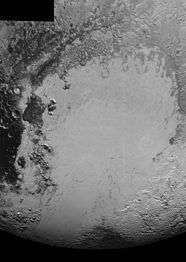
 View of Tombaugh Regio (Pluto's 'Heart'). The bright white uplands on the right may be coated by nitrogen transported via the atmosphere from Sputnik Planitia (on the left), and then deposited as ice.
View of Tombaugh Regio (Pluto's 'Heart'). The bright white uplands on the right may be coated by nitrogen transported via the atmosphere from Sputnik Planitia (on the left), and then deposited as ice..png) Closeup view of the planitia's northern 'shoreline' at the margin of the al-Idrisi Montes
Closeup view of the planitia's northern 'shoreline' at the margin of the al-Idrisi Montes
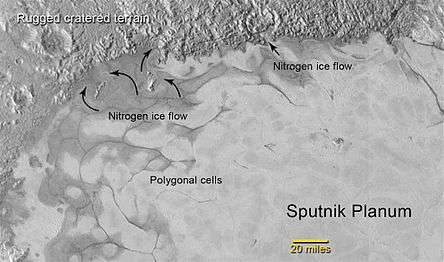
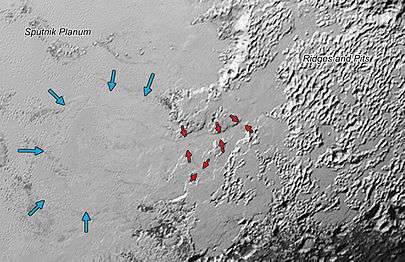
 Nitrogen ice glaciers flowing into the planitia's eastern margin in a similar reprojected backlit view (context); valleys are 3 to 8 km wide
Nitrogen ice glaciers flowing into the planitia's eastern margin in a similar reprojected backlit view (context); valleys are 3 to 8 km wide


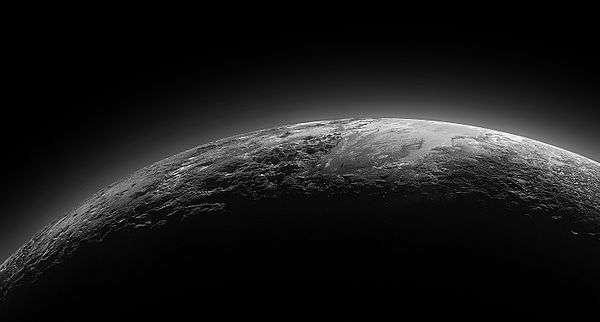
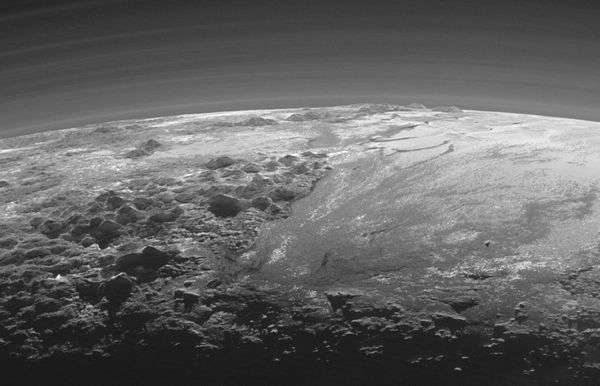
Near-sunset view includes several layers of atmospheric haze.
Animated videos
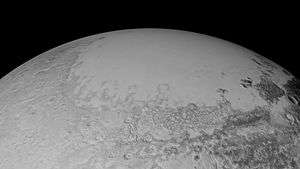
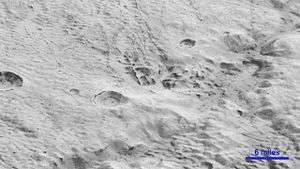
See also
| Wikimedia Commons has media related to Sputnik Planitia. |
References
- ↑ Lakdawalla, Emily (2016-10-26). "DPS/EPSC update on New Horizons at the Pluto system and beyond". The Planetary Society. Retrieved 2016-10-26.
- 1 2 3 4 5 6 7 8 Lakdawalla, Emily (2015-12-21). "Pluto updates from AGU and DPS: Pretty pictures from a confusing world". The Planetary Society. Retrieved 2016-01-24.
- 1 2 3 Gary, Stuart. "NASA'S New Horizons discovers frozen plains in the heart of Pluto's 'Heart'". Retrieved 1 May 2016.
- 1 2 "New high-resolution images show Pluto's 'icy, frozen plains'". TheVerge.com. Retrieved 18 July 2015.
- 1 2 "New Horizons". Pluto.jhuapl.edu. Retrieved 18 July 2015.
- 1 2 Staff (17 July 2015). "NASA – Video (01:20) – Animated flyover of Pluto's icy mountain and plains". NASA & YouTube. Retrieved 18 July 2015.
- ↑ Marchis, F.; Trilling, D. E. (2016-01-20). "The Surface Age of Sputnik Planum, Pluto, Must Be Less than 10 Million Years". PLOS ONE. 11 (1): e0147386. arXiv:1601.02833
 . Bibcode:2016PLoSO..1147386T. doi:10.1371/journal.pone.0147386.
. Bibcode:2016PLoSO..1147386T. doi:10.1371/journal.pone.0147386. - 1 2 Umurhan, O. (2016-01-08). "Probing the Mysterious Glacial Flow on Pluto's Frozen 'Heart'". blogs.nasa.gov. NASA. Retrieved 2016-01-24.
- ↑ Witze, A. (2016-10-21). "Icy heart could be key to Pluto's strange geology". Nature. 538 (7626): 439–439. doi:10.1038/nature.2016.20856.
- ↑ Bertrand, T.; Forget, F. (2016-09-19). "Observed glacier and volatile distribution on Pluto from atmosphere–topography processes". Nature. 540 (7631): 86–89. doi:10.1038/nature19337.
- 1 2 Keane, J. T.; Matsuyama, I. (2016). "Pluto followed its heart: true polar wander of Pluto due to the formation and evolution of Sputnik Planum" (PDF). 47th Lunar and Planetary Science Conference. Woodlands, Texas. p. 2348.
- 1 2 3 4 Keane, J. T.; Matsuyama, I.; Kamata, S.; Steckloff, J. K. (2016-11-16). "Reorientation and faulting of Pluto due to volatile loading within Sputnik Planitia". Nature. doi:10.1038/nature20120.
- ↑ Bertrand, T.; Forget, F. (2016-09-19). "Observed glacier and volatile distribution on Pluto from atmosphere–topography processes". Nature. doi:10.1038/nature19337.
- 1 2 Hamilton, D. P.; Stern, S. A.; Moore, J. M.; Young, L. A. (2016-11-30). "The rapid formation of Sputnik Planitia early in Pluto's history". Nature. 540 (7631): 97–99. doi:10.1038/nature20586.
- 1 2 Nimmo, F.; Hamilton, D. P.; McKinnon, W. B.; Schenk, P. M.; Binzel, R. P.; Bierson, C. J.; Beyer, R. A.; Moore, J. M.; Stern, S. A.; Weaver, H. A.; Olkin, C. B.; Young, L. A.; Smith, K. E.; Moore, J. M.; McKinnon, W. B.; Spencer, J. R.; Beyer, R.; Binzel, R. P.; Buie, M.; Buratti, B.; Cheng, A.; Cruikshank, D.; Ore, C. Dalle; Earle, A.; Gladstone, R.; Grundy, W.; Howard, A. D.; Lauer, T.; Linscott, I.; Nimmo, F.; Parker, J.; Porter, S.; Reitsema, H.; Reuter, D.; Roberts, J. H.; Robbins, S.; Schenk, P. M.; Showalter, M.; Singer, K.; Strobel, D.; Summers, M.; Tyler, L.; White, O. L.; Umurhan, O. M.; Banks, M.; Barnouin, O.; Bray, V.; Carcich, B.; Chaikin, A.; Chavez, C.; Conrad, C.; Hamilton, D. P.; Howett, C.; Hofgartner, J.; Kammer, J.; Lisse, C.; Marcotte, A.; Parker, A.; Retherford, K.; Saina, M.; Runyon, K.; Schindhelm, E.; Stansberry, J.; Steffl, A.; Stryk, T.; Throop, H.; Tsang, C.; Verbiscer, A.; Winters, H.; Zangari, A.; Stern, S. A.; Weaver, H. A.; Olkin, C. B.; Young, L. A.; Smith, K. E. (2016-11-16). "Reorientation of Sputnik Planitia implies a subsurface ocean on Pluto". Nature. doi:10.1038/nature20148.
- ↑ McKinnon, W. B.; Nimmo, F.; Wong, T.; Schenk, P. M.; White, O. L.; Roberts, J. H.; Moore, J. M.; Spencer, J. R.; Howard, A. D.; Umurhan, O. M.; Stern, S. A.; Weaver, H. A.; Olkin, C. B.; Young, L. A.; Smith, K. E.; Beyer, R.; Buie, M.; Buratti, B.; Cheng, A.; Cruikshank, D.; Dalle Ore, C.; Gladstone, R.; Grundy, W.; Lauer, T.; Linscott, I.; Parker, J.; Porter, S.; Reitsema, H.; Reuter, D.; Robbins, S.; Showalter, M.; Singer, K.; Strobel, D.; Summers, M.; Tyler, L.; Banks, M.; Barnouin, O.; Bray, V.; Carcich, B.; Chaikin, A.; Chavez, C.; Conrad, C.; Hamilton, D.; Howett, C.; Hofgartner, J.; Kammer, J.; Lisse, C.; Marcotte, A.; Parker, A.; Retherford, K.; Saina, M.; Runyon, K.; Schindhelm, E.; Stansberry, J.; Steffl, A.; Stryk, T.; Throop, H.; Tsang, C.; Verbiscer, A.; Winters, H.; Zangari, A. (2016-06-01). "Convection in a volatile nitrogen-ice-rich layer drives Pluto's geological vigour". Nature. 534 (7605): 82–85. doi:10.1038/nature18289.
- ↑ Trowbridge, A. J.; Melosh, H. J.; Steckloff, J. K.; Freed, A. M. (2016-06-01). "Vigorous convection as the explanation for Pluto's polygonal terrain". Nature. 534 (7605): 79–81. doi:10.1038/nature18016.
- 1 2 3 Keeter, B. (2016-01-11). "'X' Marks a Curious Corner on Pluto's Icy Plains". NASA. Retrieved 2016-01-24.
- ↑ Kornfeld, L. (2016-01-09). "New high-resolution images show ice flow on Pluto's surface". Spaceflight Insider. Retrieved 2016-01-25.
- 1 2 "Pluto's Mysterious, Floating Hills". New Horizons mission web site. Johns Hopkins University Applied Physics Laboratory. 2016-02-04. Retrieved 2016-02-11.
- ↑ "NASA's New Horizons Discovers Exotic Ices on Pluto". SciNews.com. 24 July 2015. Retrieved 25 July 2015.
- ↑ Nemiroff, R.; Bonnell, J., eds. (18 July 2015). "Fly Over Pluto". Astronomy Picture of the Day. NASA. Retrieved 27 July 2015.
- ↑ Pokhrel, Rajan (19 July 2015). "Nepal's mountaineering fraternity happy over Pluto mountains named after Tenzing Norgay Sherpa - Nepal's First Landmark In The Solar System". The Himalayan Times. Retrieved 19 July 2015.
- ↑ "Brasil recebe nomenclatura em Plutão". GOASA.
- ↑ "At Pluto, New Horizons Finds Geology of All Ages, Possible Ice Volcanoes, Insight into Planetary Origins". New Horizons News Center. The Johns Hopkins University Applied Physics Laboratory LLC. 2015-11-09. Retrieved 2015-11-09.
- ↑ Witze, A. (2015-11-09). "Icy volcanoes may dot Pluto's surface". Nature News and Comment. Nature Publishing Group. Retrieved 2015-11-09.
- ↑ Chang, Kenneth (17 July 2015). "Pluto terrain yields big surprises in New Horizons images". New York Times. Retrieved 17 July 2015.
- ↑ Klotz, I. (2016-03-28). "Pluto May Have Nitrogen Lakes That Freeze and Thaw". Discovery.com. Discovery Communications, LLC. Retrieved 2016-03-30.
- ↑ Keeter, W. (2016-03-24). "Pluto: On Frozen Pond". NASA.gov. NASA. Retrieved 2016-03-30.
Notes
- ↑ Also /ˈspʊtnɪk pləˈnɪʃiə/



.png)


.jpg)